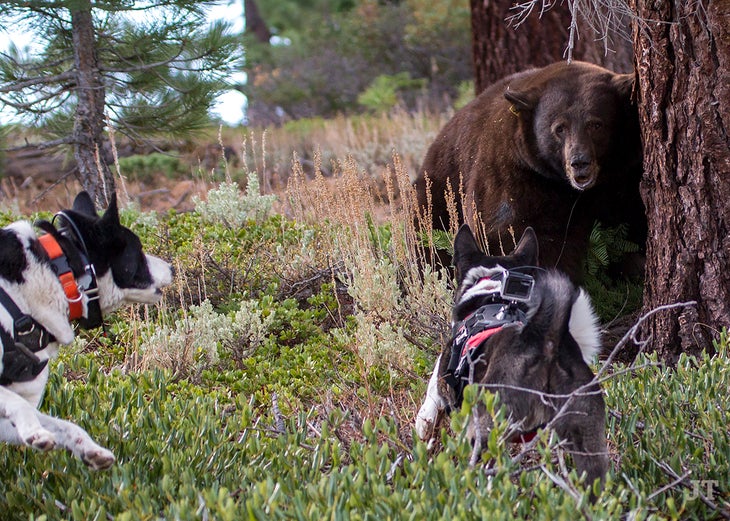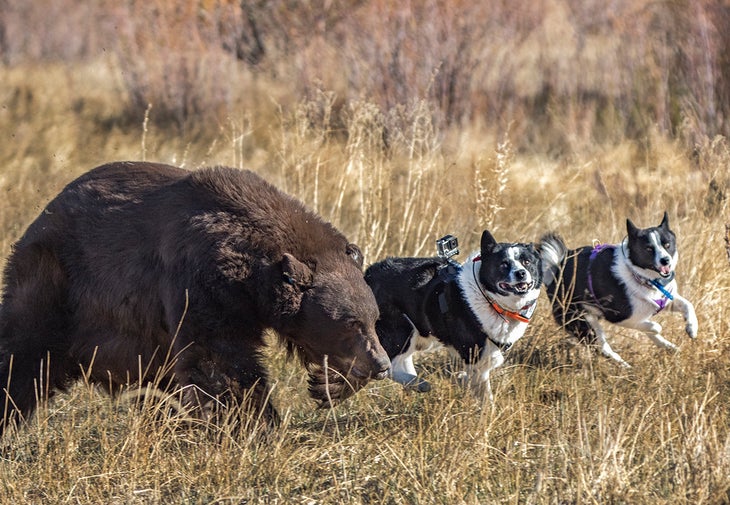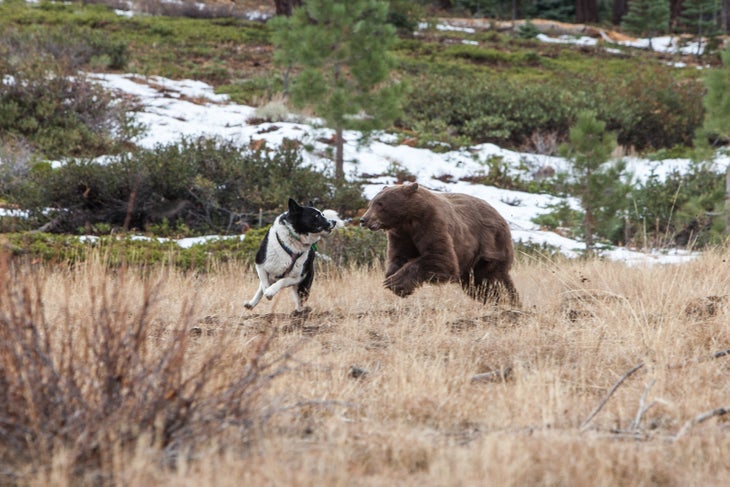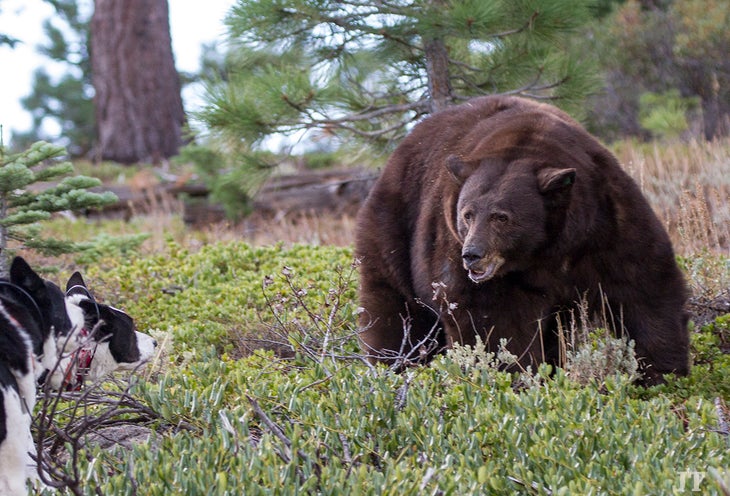Heading out the door? Read this article on the new Outside+ app available now on iOS devices for members! Download the app.

A pair of Karelian bear dogs haze a bear.

Karelian bear dogs non-lethally drive off bears by hazing them.

Wildlife departments and non-profits around the country have begun to use Karelian bear dogs as deterrents, but most are funded by donations.

A bear and a pair of Karelians face off.
Carl Lackey is out in the woods of Nevada’s Carson Valley with his three-year-old Karelian bear dog. Dazzle, who’s the size of a husky and has a black and white face, striped like a skunk, is a sweet, mellow pup, curious and lovable. Until she spots a bear.
“When these dogs see a bear, it’s like Dr. Jekyll and Mr. Hyde,” says Lackey, a 52-year-old bear biologist with the Nevada Department of Wildlife. “They flip a switch. They don’t become aggressive. They don’t want to attack. But they get right in that bear’s face. They bark, bark, bark. Think of the dogs as gnats. You can’t get rid of them. That’s what these dogs do to bears. They just annoy the hell of out them. The bears finally say, ‘I’ve had enough.’”
Karelian bear dogs are natural and fearless hunters, bred and specially trained to haze bears and other large wildlife by running them out of areas where they’re not welcome. Ideally, the hazing trains the bear to stay away for good. And with a growing number of bear-human conflicts in recent years—state officials, homeowners, and hunters kill 1,000 each year in Colorado alone—we might need these dogs now more than ever before.
A grizzly bear killed a hiker in Yellowstone National Park in 2015; afterwards, park officials destroyed the animal. While the incident was serious, it was also relatively rare: Yellowstone National Park reports that while more than 104 million people visited the park between 1980 and 2015, only 38 were injured by grizzly bears, making your chances of a run-in with a grizzly about 1 in 2.7 million. You have roughly the same odds of winning the Powerball jackpot.
Where there is a spike in bear issues, some evidence points to an increase in humans living and recreating in bear habitat as a prime cause. Alaska provides a prime example.“Human-bear conflicts [in Alaska] are very rare events (2.6 per year overall), and recent increases—up to 7.6 a year in the most recent decade—closely track population increases, but may be due to other, undocumented variables,” reports Tom Smith, an associate professor of wildlife at Utah’s Brigham Young University who has a forthcoming study on Alaskan bear conflicts.
Relocating the bears rarely works. “We used to take these bears 50, 60, 100 miles away from where we caught them, only to find out they came back anyway,” says Rich Beausoleil, a bear and cougar specialist with the Washington Department of Fish and Wildlife who owns two Karelian bear dogs named Cash and Indy. “Then the bears either got hit by a car trying to get back to their home or, because you dumped them in some other animal’s backyard, they got hurt in a fight. We’ve got to leave these animals where they are and focus on the problem.”
Enter the dogs. Karelian bear dogs originated in parts of Finland and western Russia, where brown bear and moose hunters used them for centuries. They didn’t arrive in the United States until the 1990s, when a bear biologist named Carrie Hunt imported them. Hunt would go on to found the Wind River Bear Institute, a Montana-based non-profit whose purpose is to reduce bear-human conflicts. By using “bear shepherding”—driving troublesome ursines off with dogs—she aimed to improve human safety while reducing bear deaths.
Lackey first heard of Karelian bear dogs from a National Geographic special in 2001. Soon after, he adopted his first, a rescue pup from Montana. There was just one problem: his new friend was afraid of bears.
“I went to a presentation with the new pup and someone had brought in a full life-sized bear,” recalls Lackey. “The dog hid behind me and looked at the bear between my legs. I said, ‘This isn’t going to work.’” He gave the puppy to a friend and took out a loan to buy his first working Karelian, Stryker.”
While other breeds of dog have been used to hunt bears, none are as good at chasing them off as Karelians. “They’re incredibly brave,” says Beausoleil. “A handler can do with one of these dogs what hunters need five dogs of another breed for. They make us more efficient.”
There’s evidence for the dog’s effectiveness. Lackey, along with biologists at the University of Nevada, Reno, conducted a study in 2002 to test the effectiveness of multiple types of deterrents on black bears, including pepper spray, rubber bullets, loud explosive noises, and using Karelian bear dogs and hounds. They found that 53 percent of the bears returned to their original location within a month of being chased off, but that bears hazed with dogs stayed away an average of three times as long.
Still, not everyone agrees with those tactics. Lackey, for his part, is involved in multiple lawsuits. He filed a defamation lawsuit last March against a bear advocacy group called the BEAR League and several individuals, citing an online smear campaign that painted him in a negative light. One individual named in the lawsuit, Nevada Wildlife Alliance co-founder Mark Smith, fired back with a lawsuit of his own in July, alleging slander and civil conspiracy, among other charges.
No matter how fearless Karelian bear dogs are, even advocates say they won’t be enough to solve the bear problem on their own. The real challenge, says Beausoleil, is changing attitudes.
“The dogs buy us time to educate,” says Beausoleil. “They push the bear away from people and then we talk to people, show them why the animal is there, and try to get them to remove the attractants [like trash or food] before another animal tries taking advantage of it.”
There are only a few dozen Karelians currently working in the U.S. today, mainly with dog handlers in state and federal agencies in Nevada, Alaska, Montana, and Washington, as well as some private contractors, and a long-running program near Canada’s Banff National Park. The dog programs are expensive, and for fear of budget cuts, most state-level Karelian bear dog programs are funded entirely by private donations and fundraisers. The dogs live in their handlers’ homes, just like a regular household pet. Well, sort of.
“There’s no days off with these dogs,” says Beausoleil. “There’s no Sunday morning walk in the park. Everything is a hunt.”